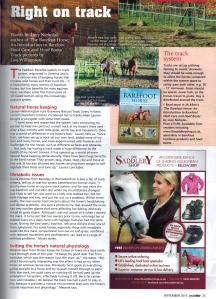By Lucy Nicholas, author of ‘The Barefoot Horse: An Introduction to Barefoot Hoof Care and Hoof Boots’
The Paddock Paradise system, or track system, originated in America and is a natural way of keeping horses that imitates wild horses and their herd life – it is favoured by many owners of barefoot horses, but has benefits for most equines. Here, in our latest blog- taken from our recent feature in Local Rider Magazine we share some first-hand views of UK-based owners using this increasingly popular system.
Natural horse keeping
Lauren Hetherington runs Graveney Natural Track Livery in Kent; Lauren’s barefoot trimmer introduced her to tracks when Lauren bought a youngster with some hoof issues.
Lauren says...
“I went away and researched the system, later convincing my partner to help me construct a small track at my horse’s livery yard - after a few months with little grass, ad lib hay and movement, there was a world of difference in my horse's feet,” Lauren tells us. “Since then, we have set up a track on our own land, added more of my own and livery horses, and have experimented with features and challenges for the horses, such as different surfaces and obstacles.
Not only has having a track made a huge difference to the health of my horses’ hooves, it has opened up a world of more natural horse keeping. Behaviourally, there have been huge benefits to the herd horses. They groom, play, chase, feed, rest and move at free will. It has also allowed any horses carrying more weight to self regulate their food, and tone up,” Lauren concludes.
Metabolic issues
Nicola Downes from Bewdley in Worcestershire is also a fan of track systems, telling Local Rider Magazine that the system benefited her former mare.
She says...
“I put my new horse on my own track system, and for two years she was barefoot and out 24/7. But when my circumstances changed and I had to sell her, she went to a lady who stabled her, fed her both haylage and hay, and put her out on a paddock. Within three weeks, the new owner had concerns about the horse’s headshaking and dental problems - she sent a photo to me that showed the mare had very swollen glands that were affecting her eating; obviously linked to grass intake. Although I was not aware of it when I owned the mare, it turns out that her owners prior to me, who kept her at stabled livery on a dairy farm with haylage, had also had the same issues. During the two years I had her, not once did she show any of these symptoms. For some horses, especially those with metabolic issues like this mare, conventional turn out on lush grass, combined with reduced movement and confinement, can lead to a range of wellness problems,” Nicola states.
Suiting the horse’s natural physiology
Melanie Isaac from Dorset keeps her horses at livery on a bare earth track through most of the year.
“It keeps my good doer free from navicular, which was the reason I put the track up,” she states. “But what I found really interesting was the affect it had on my other horse, an anxious rescue case. Previously he’d spook at everything, gallop straight to a fence and try to push himself through in panic. With the track, he could carry on running till he had used up the adrenalin in his system, effectively running it off. He is far calmer now, and rideable; I do believe the track has had a part to play in this, because it provides a natural environment that suits the horse’s natural responses and physiology,” Melanie says.
So how do you create a track system?
Tracks are set up utilising fencing to create 'channels' - they should be wide enough to allow the horses contained within the system space to safely pass each other e.g 10-12 foot min. Grass should be sparse, never lush, encouraging the horse's to travel to graze. Hay should also be distributed around the track where required.
If you are interested in a track system and/or barefoot hoof care why not read more in 'The Barefoot Horse; An introduction to Barefoot Hoof Care and Hood Boots' by Lucy Nicholas. Price £15.99. Available from retailers including www.thesaddleryshop.co.uk, specialists in barefoot hoofcare products and hoof boots.

No comments:
Post a Comment